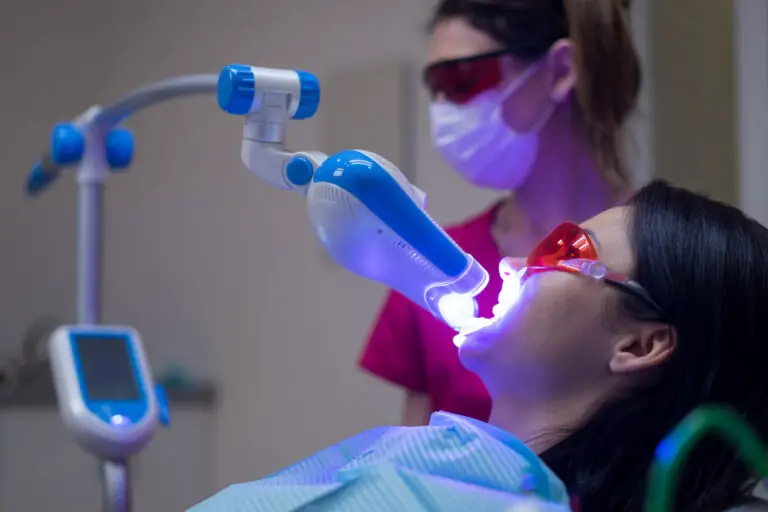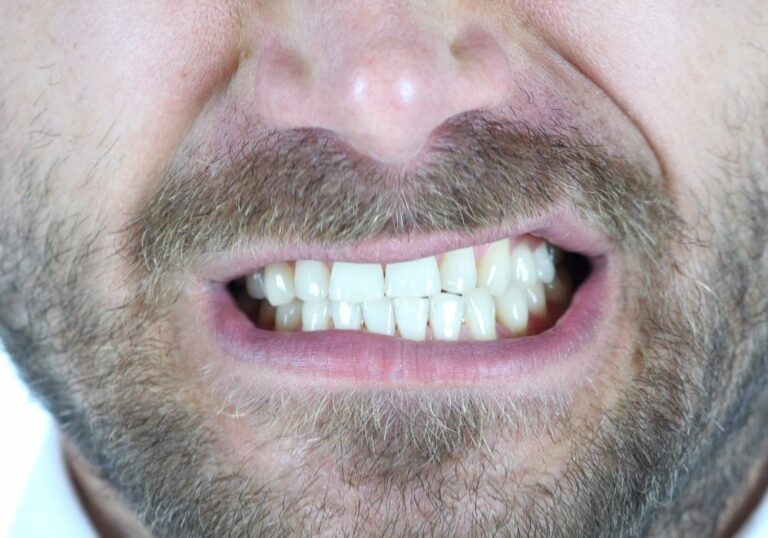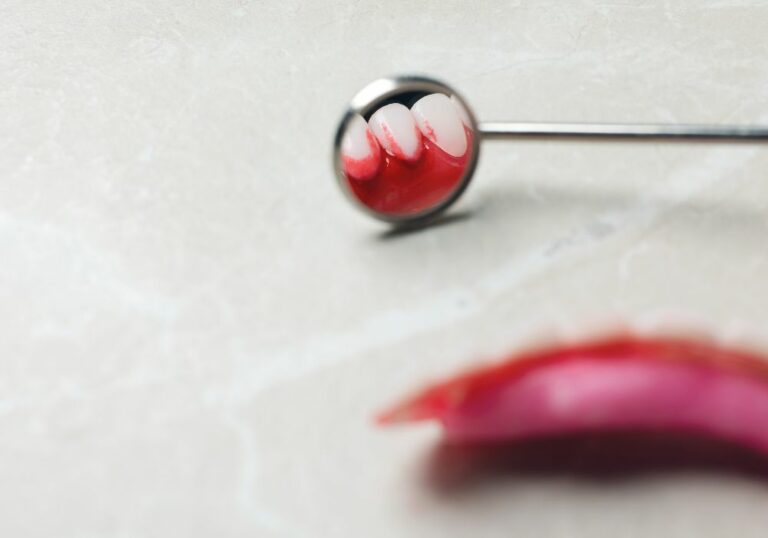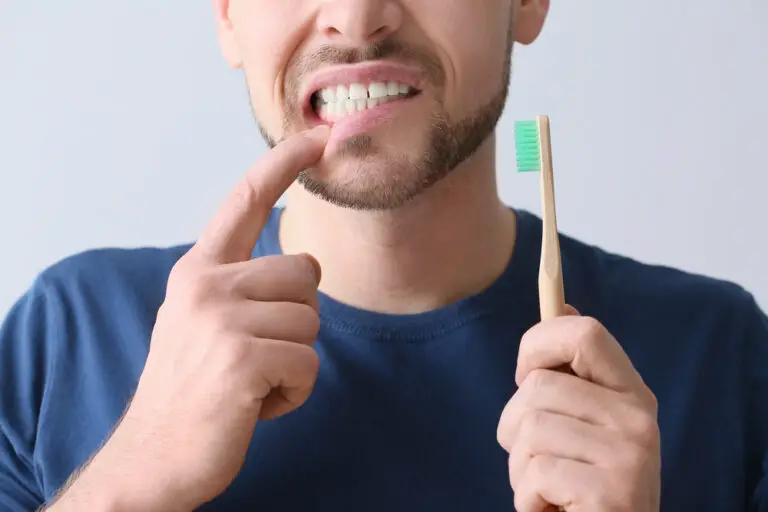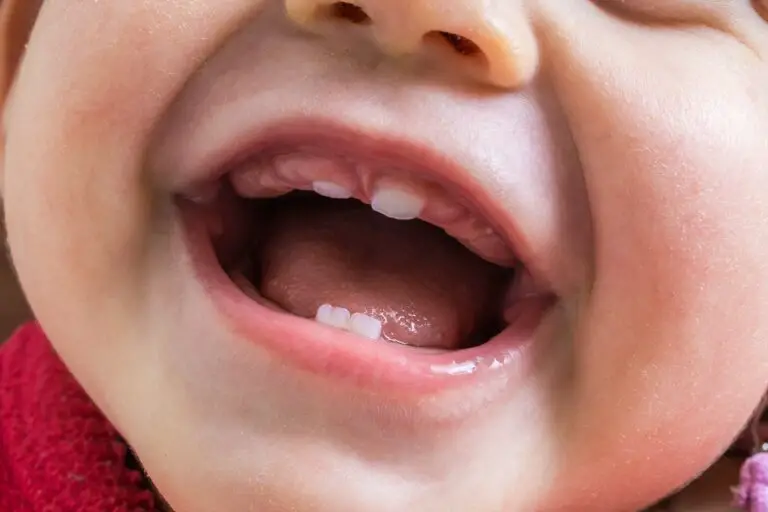As a parent, you want your child to have the healthiest smile possible. However, if you’ve noticed your 8 year old’s teeth looking more yellow than they should be, it’s understandable to have some concerns. While some yellowing is normal as baby teeth transition to adult teeth, excessive yellowing or staining can indicate an oral health problem. Understanding the most common reasons behind yellow teeth can help you get your child the right treatment.
Reasons for Yellow Teeth in 8-Year-Olds
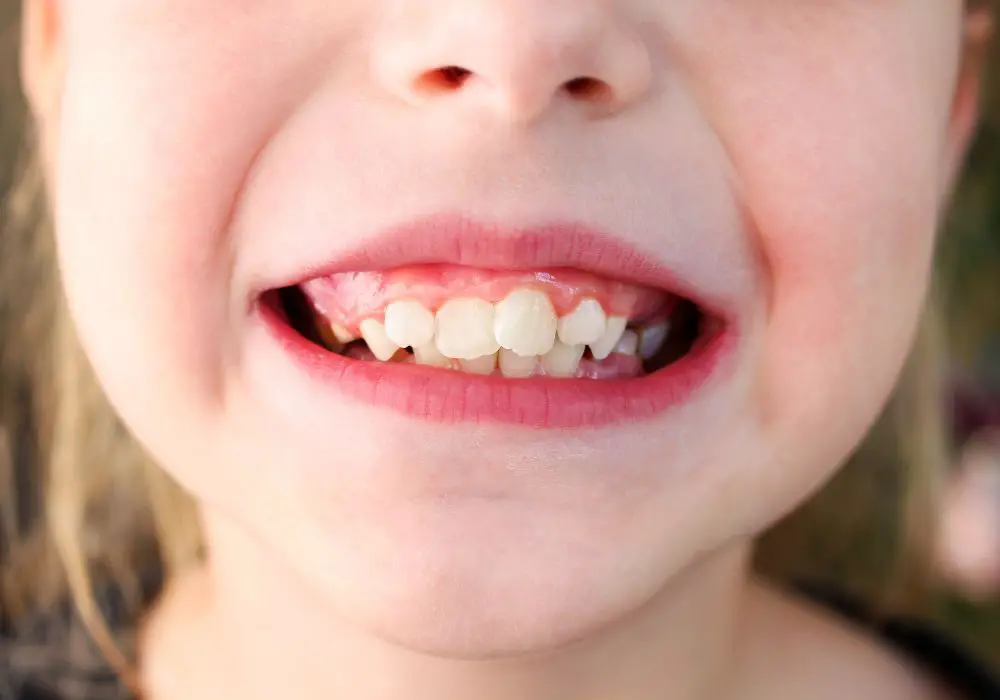
There are several potential culprits that could be making your 8-year-old’s teeth appear yellow. Here are some of the most likely causes:
1. Enamel Hypoplasia
Enamel hypoplasia occurs when the tooth enamel does not fully form during the initial enamel formation phase. This can leave the yellow-hued dentin exposed and visible through the thin or missing enamel.
Causes of enamel hypoplasia include:
- Poor nutrition during pregnancy and early childhood such as deficiencies in calcium, vitamin D, vitamin A, and protein. These minerals are essential building blocks for strong enamel formation.
- Birth defects such as cleft lip and palate that disrupt development.
- Childhood diseases like chickenpox, measles, or flu. High fevers during illness can damage developing enamel.
- Exposure to too much fluoride before the age of 8. Excess fluoride intake from water or supplements impacts enzyme function needed for enamel mineralization.
- Trauma to primary teeth. Injuries that fracture, displace or extract teeth can damage permanent tooth buds developing under the gums.
- Genetic disorders like Amelogenesis imperfecta that impair enamel production.
- Endocrine disorders like hypothyroidism that affect hormone levels important for dental growth.
- Celiac disease which interferes with nutrient absorption.
- Kidney disorders that disrupt calcium and phosphate levels needed for enamel.
- Cancer treatments like radiation and chemotherapy drugs given at an early age.
Because enamel does not regenerate or repair itself once damaged initially, the extent of hypoplasia depends on when and how long these insults occur while the permanent teeth are still forming under the gums.
2. Tooth Decay
Cavities from tooth decay can also lead to yellowing as enamel is lost. The decay process allows bacteria to work their way through the white opaque enamel and progress into the yellowish softer dentin layer found beneath it. This shows through as a yellowish discoloration.
Tooth decay is more likely to occur when a child has risk factors like:
- Poor oral hygiene habits such as inadequate or infrequent brushing and flossing. This allows plaque bacteria to remain on the teeth longer and produce enamel-damaging acid.
- Frequent snacking and sipping on sugary foods and acidic drinks like juice, soda, or sports drinks. This feeds the bacteria and constantly bathes the teeth in acid.
- Reduced saliva flow during the day or night that fails to neutralize acid and wash away food particles. Certain medications, health conditions, and mouth breathing can impact saliva.
- High risk areas of the teeth go overlooked. Decay forms more often in the grooves, pits, and back molars that are hard to keep clean.
- Frequent acid reflux brings stomach acid into contact with the teeth. This acid softens and erodes enamel.
- Orthodontic braces or oral appliances that trap food against the teeth.
- Take certain medications with sugar. Some medication formulas contain sugar that fuels bacteria if allowed to remain on the teeth after taking.
3. Dental Trauma
Injuries to primary teeth can also cause yellowing. The impact may fracture or chip the enamel exposing the yellowish dentin beneath. In cases of an intruded tooth, the pressure can damage the pulp tissue inside the tooth causing it to change color.
As a damaged primary tooth then goes through the healing process, it may take on a yellowish-grey discoloration. The injured tooth may respond by laying down more reparative dentin which is also yellow in color.
4. Certain Medications
Some medications are known to stain teeth more readily. This can occur in a couple ways:
- Metal particulates in liquid medications can embed in the porous enamel. Silver-containing medications like silver sulfadiazine can leave grey, brown, or black stains.
- Antibacterial medications like tetracyclines and doxycycline can deposit in developing teeth and cause intrinsic discoloration of the dentin that shows through the enamel later on. Children under age 8 are most susceptible.
- Antihistamines, antipsychotics, and hypertension drugs can reduce saliva flow. This allows more staining-causing molecules to adhere to the teeth unwashed.
- Chemotherapy drugs given during childhood impact cellular activity when teeth are still developing under the gums. This can disrupt normal color formation.
- Asthma inhalers deliver medications directly to the teeth. With frequent use, staining can build up.
5. Dental Fluorosis
Dental fluorosis causes white specks, cloudy areas, or streaks on teeth ranging from barely noticeable to confluent. In moderate to severe cases, this overlapping fluorosis damage can blend together making the teeth look more yellowed or even brownish.
Fluorosis occurs from excessive ingestion (or less commonly absorption through the gums) of fluoride while the permanent teeth are still forming under the gums during the first 8 years of life.
The discoloration is caused by disruption of the enamel matrix proteins such as amelogenin that are needed to form the crystalline calcium phosphate mineral tooth structure. Sources of excess fluoride include:
- Fluoridated drinking water, especially if swallowed instead of just rinsed through the mouth. Well water in some geographic areas contains very high natural fluoride levels.
- Fluoride toothpastes repeatedly swallowed in large amounts by young children.
- Too much or inappropriate use of fluoride supplements.
- Fluoride treatments like varnish applied too frequently.
- Excess ingestion of fluoride-containing products like juice, tea, dental rinses, or processed foods made in fluoridated areas.
- Eating clay with high fluoride content.
The risk of fluorosis depends on both the dose of fluoride intake and the child’s age. Because enamel forms gradually over time, excessive fluoride ingestion during all the years of enamel development can result in fluorosis.
6. Periodontal or Gum Disease
Gum disease is less common in children than adults but can occur. Periodontitis causes inflammation and destruction of the gums, bone, and other supporting structures around the teeth. This can lead to yellowing in a couple ways:
- Destruction of the bony socket around a tooth leaves less support and gives the tooth a longer, yellower appearance.
- As gum and bone tissue are lost around the tooth, more of the natural yellowish root surface becomes exposed and visible.
- The increased tooth mobility and trauma from periodontitis can impact the blood supply to a tooth or damage the pulp giving it a darker, greyer look.
Gum disease in children is typically aggressive early onset periodontitis. It is associated with systemic health factors like diabetes or genetic susceptibilities like leukocyte adhesion deficiency syndrome. The rapid bone loss allows visible yellowing of the teeth to occur.
7. Thick Dental Plaque
When poor oral hygiene allows layers of plaque to build up on the teeth, this can take on a yellow to brown appearance. Plaque is a sticky film of bacteria, food debris, and saliva minerals. As it accumulates, it becomes more visible. Without a thorough cleaning, this dull yellow plaque can remain on the teeth.
8. Food Staining
While eating and drinking, particles of strongly colored foods can embed in the microscopic fissures, grooves, and pores of the enamel. This stains the teeth over time. Common culprits include coffee, tea, soda, dark berries, tomato sauce, soy sauce, curry, and hard candies. The longer the teeth are exposed to staining foods, the more accumulated discoloration.
9. Tobacco Use
Any form of tobacco use can stain and yellow the teeth due to the tar and nicotine content. This includes smoking or chewing tobacco. The tongue studs and lip piercings common with teen tobacco users also cause more staining by chipping the enamel edges of teeth.
When to See a Dentist
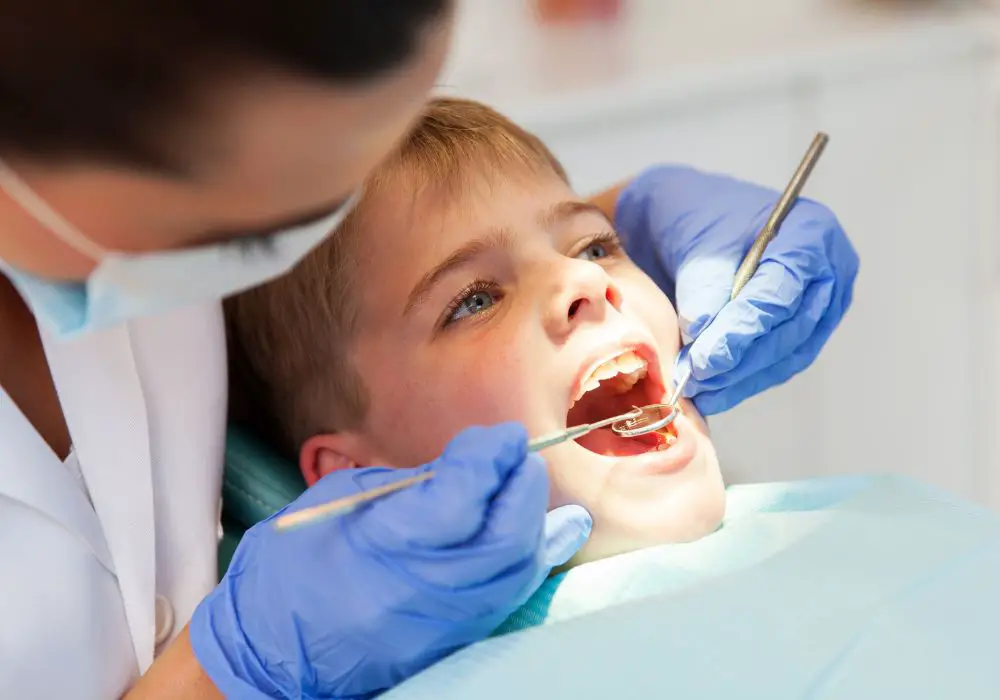
It’s a good idea to take your child to the dentist soon if you notice any significant yellowing of their teeth or other oral health concerns. A dental exam can help identify the cause, severity, and best treatment for yellowing. The dentist can:
- Perform a clinical assessment of all the teeth, looking for patterns of discoloration and associated factors like decay or trauma.
- Check for signs of oral health problems leading to yellowing like gum inflammation or dry mouth.
- Use various dental instruments to detect subtler enamel irregularities not visible to the eye that may contribute to yellowing.
- Take dental radiographs or x-rays to view the inner tooth structure and examine for issues like hidden decay, pulp changes, or damage from prior injury.
- Clean the teeth to remove any surface stains and evaluate the true tooth color underneath.
- Provide preventive treatments like sealants, fluoride applications, or prescription strength fluoride toothpaste to strengthen enamel.
- Recommend the need for follow up care with dental specialists like pediatric dentists, orthodontists, periodontists, or endodontists.
Early intervention helps prevent small problems from becoming more serious and damaging. It also helps instill good oral hygiene habits in your child when they are young and receptive.
Signs It’s Time for a Dental Visit:
Take your child to the dentist promptly if you notice any of the following signs:
- Yellow spots or streaks appearing on multiple teeth
- White, chalky spots or lines on teeth
- Teeth stained brown, grey, or black
- Teeth that are chipped, cracked, or appear structurally abnormal
- Primary teeth that are loose without signs of permanent teeth pushing them out
- Red, swollen, or bleeding gums
- Persistent bad breath
- Foul taste in the mouth
- Increased sensitivity to hot or cold foods and drinks
- Dental pain felt during eating or spontaneously
These symptoms indicate a problem likely requiring professional assessment and care to prevent complications. The sooner you seek dental evaluation, the better chance you have of reversing damage and protecting healthy teeth.
Preventing Yellowing of Children’s Teeth
Along with regular professional dental care, you can help keep your child’s smile pearly white with these daily oral hygiene and dietary practices:
Promote Diligent Oral Hygiene
- Supervise brushing twice daily for 2 minutes to ensure plaque is removed thoroughly.
- Use a soft nylon bristle toothbrush that won’t damage enamel. Change it every 3 months, after illness, and drop it if the bristles splay.
- Use a smear of fluoride toothpaste approved for young children. Have the child spit gently after brushing and avoid rinsing which washes away protective fluoride.
- Help floss between teeth daily before bedtime paying extra attention to the back molars.
- Rinse daily with an over-the-counter children’s fluoride mouthwash at night.
- Teach your child to brush or at least rinse with water after eating staining foods.
Provide a Tooth-Friendly Diet
- Offer a variety of crunchy fruits and vegetables which help clean teeth mechanically and stimulate saliva.
- Choose cheese, milk, and yogurt which contain enamel-strengthening calcium and protein.
- Limit frequency of sugary or acidic treats and drinks. When allowed, consume them along with a meal which generates more saliva flow and less decay-causing acid.
- Avoid frequent snacking throughout the day outside of meal times to limit acid attacks.
- Remind your child to take medication only with a glass of water, never sugary drinks.
Monitor Medications
- Ask about potential dental side effects when new medications are prescribed. Request an alternative if discoloration is likely.
- Use sugar-free medication formulas when available to avoid feeding oral bacteria.
- Follow dosing directions carefully. Don’t allow overuse of potentially staining meds.
- Give medication at times away from brushing since enamel can be temporary softened.
- Request dye-free liquid medications when possible. Shake before use to distribute any particulates evenly.
Get Dental Sealants
- Sealants provide a plastic shield over the pits and grooves of back teeth where over 80% of cavities start. This prevents plaque from settling into vulnerable areas.
- They last 5-10 years with good oral hygiene and are most effective when placed as soon as molars come in around age 6.
Use Fluoride Treatments
- Fluoride strengthens enamel, fights bacteria, and remineralizes early decay.
- It can be applied directly to the teeth in foam, rinse, gel, or varnish form.
- Children at high risk for decay may benefit from professional fluoride 2-4 times per year.
Professional Dental Cleaning
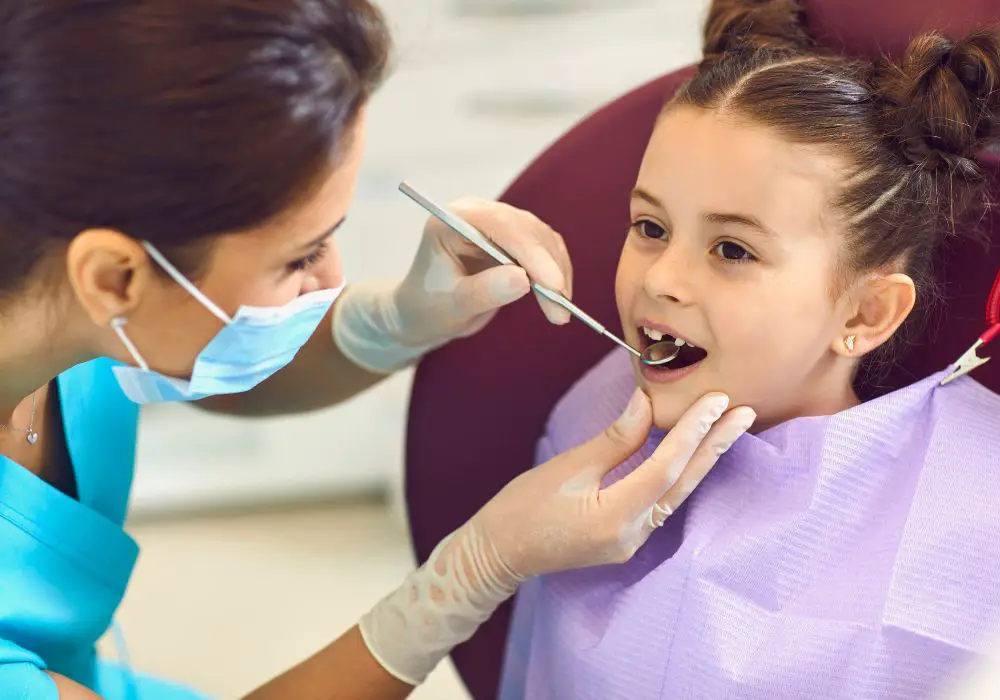
Regular professional cleanings every 6 months help prevent yellowing and promote great oral health. At your child’s cleaning visit, the dentist or hygienist will:
- Review your child’s oral hygiene routine and offer tips for improvement
- Examine the teeth and gums for any concerns
- Clean above and below the gumline
- Polish away built-up stains on the teeth
- Apply fluoride, sealants, or other protective treatments as needed
Cleanings take 30-60 minutes and are pain-free. They remove plaque buildup and surface stains that daily brushing and flossing at home may miss. Teaching your child to welcome these visits helps set the foundation for a lifetime of good oral care.
Common Questions About Yellow Teeth in Children
Why do baby teeth matter if they fall out anyway?
Primary teeth play several crucial roles, so preserving them is important. Baby teeth:
- Enable proper chewing, pronunciation, and digestion of foods needed for adequate childhood nutrition. Missing or damaged teeth can interfere with these functions.
- Hold the proper amount of space for permanent teeth. Premature loss or extraction allows remaining teeth to shift or opposing teeth to supererupt. This leads to crooked permanent teeth, bite problems, and impacted teeth.
- Allow normal development of the jaw bones and muscles needed to support the face and mouth.
- Guide permanent teeth into the proper position as they erupt since their eruption pattern follows that of the primary teeth.
- May receive injury or infection from cavities which can spread to the developing permanent tooth buds beneath.
Good oral hygiene and reduction of decay in primary teeth makes a big difference in your child’s dental health now and into the future.
Can poor nutrition cause yellowing of children’s teeth?
Yes, malnutrition during the years while permanent teeth are developing below the gumline can lead to lasting enamel defects like hypoplasia. Lack of minerals calcium, phosphorous and vitamin D prevent enamel from mineralizing normally leading to staining and weak spots.
Insufficient vitamin A can also impact tooth development and immune function leaving a child more susceptible to infections that damage enamel. Proper nutrition is especially crucial from conception to age 8 while teeth are still forming under the gums. A varied, well-balanced diet supports healthy dental development.
Should I give my child fluoride supplements?
Only provide fluoride supplements if they are recommended by your pediatric dentist. Getting the right amount of fluoride is crucial – too little increases dental decay risk but excessive amounts can permanently discolor and weaken enamel.
Whether supplements are advised depends on your child’s decay risk along with the level of fluoride in your home drinking water. In some communities the water is fluoridated to the ideal amount. But well water or unfluoridated water requires fluoride supplementation to reach optimal levels. Testing your water and discussing your child’s risk factors with your dentist determines if fluoride drops or tablets are appropriate.
Can whitening strips or professional whitening safely bleach children’s teeth?
Whitening or bleaching treatments are generally not recommended for children under age 13. Here’s why:
- Whitening strips and gels use high concentrations of hydrogen peroxide that can damage young tooth enamel which is still maturing.
- The pulp tissue inside children’s teeth is much larger relative to the tooth size and closer to the enamel surface. Whiteners may irritate this sensitive pulp tissue.
- Children are more prone to swallowing rinse-style whiteners which could harm their stomach.
However in some cases where severe intrinsic staining is present or for spot treatment of isolated areas, your dentist may deem professional in-office whitening appropriate for a child. This is the safest method due to control of the precise application and whitening levels. The products used by dental professionals contain lower hydrogen peroxide concentrations designed for children. But at-home whitening should be avoided.
When will a dentist first recommend braces for a child?
Most orthodontists recommend a first screening visit between ages 7-8 to spot potential problems and closely monitor growth and development. This allows early detection and simpler treatment of issues before growth completion.
Traditionally braces are placed between ages 8-14 while the head and mouth are still growing and teeth are more responsive to adjusting their position. But each child is unique, so see a pediatric orthodontist for an evaluation if you have any concerns about your child’s bite or straightness of teeth. An orthodontist will advise the best individual treatment timing.
Conclusion
Noticing yellowing of your 8 year old’s teeth can certainly be concerning. But in most cases, the cause is treatable. Work with your pediatric dentist to determine if enamel issues, decay, medications, trauma, or other factors are to blame. Then together you can take steps to improve tooth appearance and oral health. With your help at home and professional care, your child’s smile will stay beautiful and bright.

